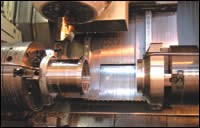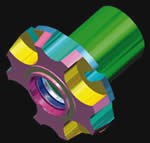Simulation Saves Cost By Balancing Workflow
Although CAM programming had been automated for many years within the Morton Grove, Illinois, facility of the John Crane Inc. (JCI) Seals Division, the shop here found a way to make the process even more efficient. It found a way to get new, complex, multi-axis turning centers into production quickly, and to maximize the productivity of these CNC machine tools in cellular manufacturing.
Share





Although CAM programming had been automated for many years within the Morton Grove, Illinois, facility of the John Crane Inc. (JCI) Seals Division, the shop here found a way to make the process even more efficient. It found a way to get new, complex, multi-axis turning centers into production quickly, and to maximize the productivity of these CNC machine tools in cellular manufacturing.
Working with EdgeCAM software from Pathtrace Systems, Inc. (Southfield, Michigan), the company has simulated thousands of previously programmed jobs and made work flow more consistent. Engineers at JCI Seals have found that simulation capabilities built into EdgeCAM software have proven essential to saving cost by reducing inventory and idle time.
JCI Seals makes metal seals, bellows, retainers and casings called “glands.” Nearly all of this work involves turned parts with complex cross sections, milled flats, indentations, and drilled and tapped holes.
Initially setting up complex turning machines to run this work can be daunting. In addition to the X and Z axes of ordinary CNC turning machines, the machines JCI uses often have C, Y and B axes. Compounding the problem of these complicated configurations is the fact that there is little standardization of workholding devices, methods and tooling from different vendors related to these machines, or in the turret configurations for these machine tools, the company says.
As a result, new turning centers here may stand idle for as long as 3 or 4 weeks as programmers struggle to mesh new machining functions with existing methods for tooling, fixturing, part programming and postprocessing. However, JCI has found a way to make this process a little less painful. Using CAM software, it can get each new multi-axis turning center out of its crate and into production in just hours.
“With EdgeCAM, our programmers can set up a new multi-axis machine and generate the first postprocessors with the EdgeCAM ‘wizard’ for posts in no more than 4 hours,” says Mike Eklove, manager of tooling engineering for the Seals Division.
Mr. Eklove notes that if the programmer is familiar with a particular machine, then the process can be accomplished in 2 hours.
In the past 3 years, JCI has invested in 14 multi-axis turning machines. The added machines have 10 different configurations, all of them have live tooling and two have sub-spindles. The company says that if any of these machines had sat idle for any length of time after uncrating, then thousands of dollars’ worth of time and parts would have been lost. JCI also acquired what it refers to as three complicated, “universal” machining centers, all of which are capable of turning or milling every side of a part in one operation.
Because the more sophisticated machines can overwhelm the output of other machines in work cells, balancing and optimizing the high output of the new equipment was essential. To address that mismatch, Mr. Eklove and his programmers deal with process variables such as cycle-time differences, which vary with lot size; cycle-time differences between similar operations on different machines; and operator workloads.
Operators at the Morton Grove facility are responsible for numerous tasks, so there may not be enough time for 1- or 2-minute secondary operations following, say, an 11-minute primary operation. This is further complicated by the fact that JCI’s newest work cells have one operator rather than two—and two machine tools rather than five. The company looked to simulation to find the right balance here.
“We use the software’s machine-cycle simulations to identify ways to specify and assign work to the multi-axis machines, balancing machining workloads on machines and the operators,” says Mr. Eklove. “This eliminates idle time for both.”
By simulating every reasonable combination of processes the company can imagine in every work cell, JCI is squeezing out all idle time associated with machines or operators.
JCI also found the software to be beneficial when it experienced two reductions of roughly 90 percent each in order quantities and job lots. To deal with the first drop in 2000 and 2001, the company reorganized its machine tools into production cells by families of parts and volumes, and then automated machine tool programming. Previously, machine tools had been organized functionally—turning, milling, drilling and tapping.
The initial productivity gains were 50 percent to 80 percent savings from eliminating work queues, buffer stocks, and work in process inventory (WIP), plus getting rid of the long and convoluted journeys parts were forced to make through the plant because of the functional arrangement. That was more than enough to offset the reduced productivity because of smaller job lots.
Then in 2003 and 2004, order quantities were squeezed an additional 90 percent. The company says that, on the factory floor, job lots that once were unthinkably small became an everyday reality.
“In the last 3 years, our average lot sizes have fallen from about 25 to three,” says Mr. Eklove. “We had some job lots go from 200 to one or two.”
With 1,100 employees, most in production, Morton Grove runs 24/7 by working four shifts a week. There was just no way to gain additional production by taking up slack in idle capacity—there wasn’t any.
However, even after automated CAM programming and cellular manufacturing, the company says that it experienced additional output and productivity gains. It accomplished this by changing the fundamental cellular manufacturing strategy from several machine tools to two and sometimes just one, thanks to multi-axis turning machines. Operators went solo as their roles changed from machinist to cell manager. Meanwhile, centralized tool cribs were replaced by vending machines located in each production area.
Though JCI changed various aspects of its operation, the company continued to rely on EdgeCAM software for programming its machine tools and, especially now, for simulating its processes. According to Mr. Eklove, he could not accurately measure part-handling time without the simulations provided by the new software.
“The main question now,” Mr. Eklove continues, “is which tasks to perform on which machines. We need to know if a new multi-axis machine relieves a bottleneck or creates one. Bottlenecks are not necessarily obvious so we have to simulate. In our simulations, we move certain operations from the mills to the multi-axis machines to keep their cycle times the same.”
JCI’s solution to the second nosedive in job-lot sizes was to use CAM simulation to allocate work between the multi-axis and the universal milling machines, virtually eliminating idle time by balancing machining workloads. As a result, the company has what Mr. Eklove refers to as “Extreme Lean.” Much like its customers, JCI says it has almost no WIP and little idle time.
Another benefit of simulating machining with EdgeCAM is being able to review the actual start-to-finish process, says the company. Within the complete process, the CAM software allows JCI to see the actual time for each machining stage so that it can evaluate options for optimizing a machining cell.
With increased capacity, the company also gained the capability to better plan shopfloor throughput.
“Simulations even help with quoting new work faster and more accurately,” says Mr. Eklove.
“We could not balance the machines’ cycle times and the operators’ workload to get a consistent flow of parts if the simulations were not right on,” he adds. “Cycle times in Version 10 are accurate to less than 1 minute. Therefore, it is a great tool with which to measure.”
For example, the company has found that spindle time in the cut is now at 40 percent of the total available time. JCI measured this on its Variaxis five-axis mill and an Integrex E-410 multi-function turning center from Mazak Corp. (Florence, Kentucky).
“Decisions based on the software’s simulations demonstrate how every operation will be shared between a cell’s machine tools,” Mr. Eklove concludes. “This gives a whole new meaning to cellular manufacturing here.”
Read Next
Registration Now Open for the Precision Machining Technology Show (PMTS) 2025
The precision machining industry’s premier event returns to Cleveland, OH, April 1-3.
Read MoreBuilding Out a Foundation for Student Machinists
Autodesk and Haas have teamed up to produce an introductory course for students that covers the basics of CAD, CAM and CNC while providing them with a portfolio part.
Read More5 Rules of Thumb for Buying CNC Machine Tools
Use these tips to carefully plan your machine tool purchases and to avoid regretting your decision later.
Read More

























.jpg;maxWidth=300;quality=90)









